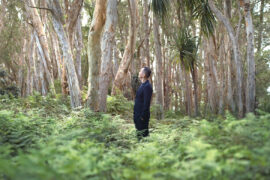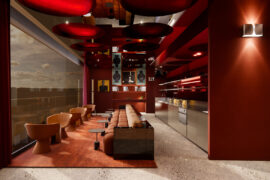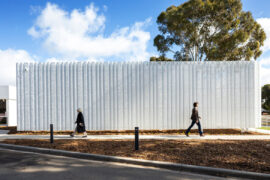The Vietnamese architect discusses insatiable construction markets and dwindling urban ecologies. For the latter, he recommends bamboo; for the former, meditation.

February 7th, 2024
This article originally appeared in INDESIGN #90, the ‘City Futures’ issue – get your copy here.
Vo Trong Nghia is a renowned meditator. (Of course, he is also a renowned architect (but that’s almost beside the point, maybe even ancillary to it.) At the height of his firm’s distinction, from 2017, he spent three years meditating at Pa Auk Forest Monastery. Upon return, he instituted a studio-wide policy of twice-daily meditations, and frequent 10-day retreats en famille.
Most irregular. So, does it make them superior architects?
“Yes of course. Meditation allows us to concentrate better,” he says. “It makes us more sensitive because it improves your ability to contemplate interests outside of your own.”

“It takes time to practice meditation well, but for us it is important because this makes our architects develop a finer ability to make decisions. It makes us more aware of the living things around us. And this includes the needs of others in society too, because it teaches us how to find balance.”
He tries to explain how this is no small feat for Vo Trong Nghia Architects, a firm, from Vietnam, avowedly at odds with the slap-it-up-tear-it-down habits of Hanoi or Ho Chi Minh City.

He instructs me to think of these places and, obediently, I do. I think of many things: jerrycans and grit and asphalt grey, too many cars, even more motorcycles, all clotting spider vein thoroughfares choking buildings already crinkled by superabundant air conditioning units. I do not think of trees. (Much less meditation.)
“In Vietnam, the Municipal Department of Construction looked at green space in the city,” he says. “Do you know, they found only 0.55 square metres of green space for each citizen? I think Ho Chi Minh City has a population of almost 9 million people, maybe more. It has changed too much and has lost its tropical beauty.
“Years ago,” he continues, “the city wanted to boom and take advantage of the economic growth. This created a lot of construction, fast construction, with concrete and steel. Nature was pushed out more and more. It became the culture.”
Related: Russell Fortmeyer on climate from INDESIGN #90

This is commonplace but, nonetheless, important context. Vo Trong Nghia Architects matured in this scene and has, since the early 2000s, built a project portfolio proposing a quiet (perhaps cunning) critique of development models laying waste to richer urban ecologies.
The firm’s counter-cultural practice has rightly garnered praise for material and market innovation, principally for a signature use of bamboo. “In 2008, we completed the Wind and Water Bar and Café, which was our first big achievement using this material,” he reflects.

It helps to think of the Bar as a logical building. But it is also weird, in a wonderful kind of way, with its ancient (capital-I Imperial) Western echoes – domes and cupolae – expressed in a just-as-ancient agrarian Vietnamese bamboo and thatch palette. Vernacular becomes archetype becomes vernacular… “Yes? …Something like that?” he politely says to my naff (and bungled) quip about architectonics… at the time, he was more interested in the formal experiment.
In fact, he remains interested in it. Nearly two decades later, last year, the studio delivered its latest bamboo structure, demonstrating advancements in craft and material innovation in the form of 42,000 bamboo culms, ropes and pins: Welcome Centre, Grand World Phu Quoc. In its interior evocations of the emblematic lotus flower and bronze drum, the Centre is certainly more sculptural and stylistic than its predecessor, but the complexities of its engineering – particularly at such outsized scale – is far more serious stuff.

With a floorplate of 1,460 square metres, this building is edging very close to the footprint of a high-rise apartment block. It makes you think: Vo Trong Nghia Architects is yet to create a project of substantial scale to see how a bamboo building might extrapolate toward the urban. But this is getting close.
Elsewhere, I glimpse what this might look like. Projects such as Urban Farming Office in Ho Chi Minh City and Chicland Hotel in Da Nang put forward Vo Trong Nghia Architects’ verdant embrace. Without bamboo, these join other buildings of many scales (such as the domestic Bat Trang House and the well-publicised House For Trees) all composed so as to allow maturing trees, cascading curtains of vines and perennial creepers to flourish – not as ornament, but simply just ‘as’.

“By allowing these plants to live there and really thrive, a lot can be achieved that improves the building function,” says Nghia. “More open walls improve the temperature regulation, for example, which is important somewhere like Vietnam. Today, it is common to just rely on air conditioning – we know how bad this is for our health. As a practice, we follow the Buddhist precepts. Existing in harmony with nature is a big part of this.”
Functional improvements, however, do not solely substantiate their right to dwell in place – but they do reify it. For instance, “with bamboo, it is a great resource. It’s super!” Nghia bursts. “In a tropical place like Vietnam, it can grow quickly and be farmed easily. It is incredibly strong and, with expert training, master-craftspeople can care for bamboo buildings for a very long time. Maybe even for generations,” he says, making reference to his first work in Australia – Green Ladder, the 2016 Fugitive Structures pavilion commissioned by the Sherman Contemporary Art Foundation, which drew attention to the potential durability of bamboo as fertile proving ground for architectural dreaming.

“If you treat it using a natural process,” he recounts, “bamboo can have a very long life. You submerge it in river water, maybe for four months, and then you smoke it using the coating on rice, the husk. This can even make it last up to fifty years.”
“I call it the steel of the twenty-first century,” he says, meditatively. “Yes. I know it is the future.”
Find out more about INDESIGN #90 and susbcribe here!
Vo Trong Nghia Architects
vtnarchitects.net







We think you might also like this profile of Kristen Whittle, which also featured in INDESIGN #90.
INDESIGN is on instagram
Follow @indesignlive
A searchable and comprehensive guide for specifying leading products and their suppliers
Keep up to date with the latest and greatest from our industry BFF's!

Rising above the new Sydney Metro Gadigal Station on Pitt Street, Investa’s Parkline Place is redefining the office property aesthetic.

The undeniable thread connecting Herman Miller and Knoll’s design legacies across the decades now finds its profound physical embodiment at MillerKnoll’s new Design Yard Archives.

London-based design duo Raw Edges have joined forces with Established & Sons and Tongue & Groove to introduce Wall to Wall – a hand-stained, “living collection” that transforms parquet flooring into a canvas of colour, pattern, and possibility.

In Naturalizing Architecture, Takada moves beyond biomimicry to propose a regenerative vision for the urban environment.

COX Architecture uses saturated colour and hotel-style amenity across the historic St Peters location, designed for Coronation Property.
The internet never sleeps! Here's the stuff you might have missed

Guests joined Cosentino for a behind-the-scenes look at The Block homes, discovering new materials and creative partnerships.

Through expert architecture, EBD Architects has provided a human face to great design and created a project that enhances the lives of people and community.